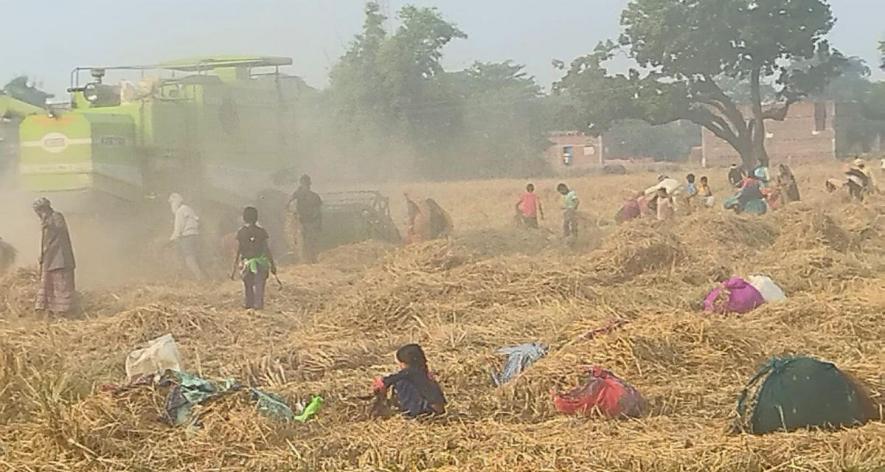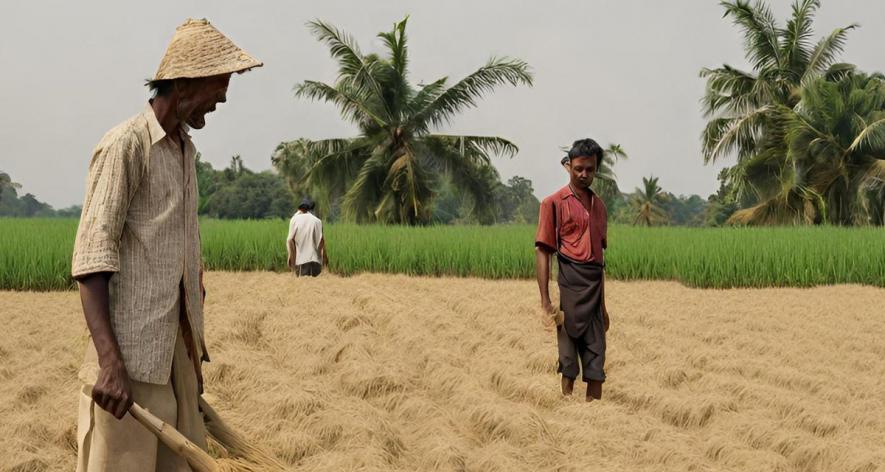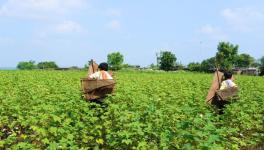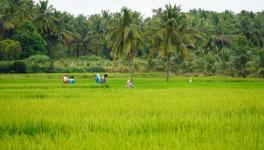Fragmented Ancestral Lands, High Input Costs do a Disservice to Young Farmers of Bihar's Bhojpur

A paddy harvester at work in Waina village
Bhojpur, Bihar: Madan Mohan Rai (72) knows that being a farmer is not just about sowing, nurturing and harvesting; it is more about doing all the work alone.
"Agriculture is no longer profitable. In the absence of viable alternatives, we are forced to carry out all farm activities ourselves," says Madan Mohan Rai, a retired government school teacher and sarpanch of Amharua panchayat in Sahar block.
Bordering Bihar's rice bowl Rohtas, the southeastern region of Bhojpur comprising Sahar block has been witnessing a constant migration of young farmers to work as urban labourers. As such, Bhojpur district is known for its paddy and wheat yields. But Madan Mohan Rai, who has been cultivating his over 20 bighas of land for the last 14 years, believes things have changed a lot.
"Tractors have replaced traditional ploughing using oxen in all villages. So, cow dung fertiliser is no longer available. We are completely dependent on chemical fertilisers from the market," he observes.
Giving a detailed cost analysis of the paddy crop, Madan Mohan Rai says the cost of running a tractor twice to prepare an acre of land was around Rs 1,800. Paddy seeds from the market would cost Rs 700 to 800. To supply water to the field through pump sets, diesel worth around Rs 2,000/acre would be needed. The field should be ploughed at least twice again before sowing, costing around Rs 2,000.
Once the paddy grows, the farmhand transplants it for Rs 2,400 per acre. At this time, a bag of urea and DAP fertiliser worth Rs 300 and Rs 1,500, respectively, are used in the field. When the paddy crop is about to get ready, urea worth Rs 300 is again used to ensure a good crop. Manual weed removal from the fields of standing paddy crops will cost Rs 1,800/acre. If it does not rain, the fields have to be watered by spending Rs 1,500. At least four watering sessions will be required, which means Rs 6,000 for that alone.
"Once done with all these chores, a harvester machine gathers the grains at Rs 1,500 per acre. Another Rs 400 should be spent on a tractor to transport the harvested grains to the farmer's house. In all, Rs 17,000 to 18,000 should be spent to cultivate paddy in one acre, leaving aside one's hard work. If everything goes well, there will be 15 to 16 quintals of paddy. After keeping aside the produce required for the family's consumption, not much money will come from it," Madan Mohan Rai says.
After all these expenses, it takes three to four months to get the money from sales if the grain is traded at government-run Agricultural Produce Market Committees. Sadly, small farmers cannot wait that long, so they are forced to sell to private buyers for a lower rate.
"Last year, the Minimum Support Price offered for the purchase of paddy through primary agricultural credit societies was Rs 1,950, while the buyers in private mandis offered only Rs 1,600 to 1,700/quintal," says Santosh Rai from Amharua.
Amharua panchayat head Deepak Sah tells 101Reporters that Kosior, Yugal Tola, and Ghatbigaha villages also fell under the panchayat. Being a canal-fed area, the cost of pumping water was less, which helped to bring down the cost of irrigation a little.
The case of the wheat crop is no different. To thresh wheat, pump sets should work for 20 hours, costing around Rs 3,000. A 40-kg bag of wheat seeds costs 2,400 to 2,500. A total of 60 kg seeds are planted in one acre, and 60 kg fertiliser is applied. Using a harvester will cost Rs 1,500, while transportation by tractor will cost another Rs 400. As farming is done in small pieces, the crop is not the same. On average, only seven to eight quintals of wheat is produced per acre, though the possible yield per acre from a big plot is 12 to 13 quintals.

Farmers working in a dry paddy field (Photo - Representative imageCanva)
Broken Into Pieces
Agriculture and allied activities employ 76% of Bihar's population and contribute around a quarter of its Gross Domestic Product (GDP) now. Notably, the GDP share was 34.9% in the triennium ending (TE) 2003–04.
Bihar is the most backward state in the country. The caste-based survey released on October 2 says Bihar's population has increased to 13.07 crore from the Census 2011 figure of 10.41 crore. As per NABARD All India Rural Financial Inclusion Survey 2016-17, the average monthly income of an agricultural household in Bihar was Rs 7,171, which was less than the national average of Rs 8,931. The rising population and division of ancestral agricultural lands have affected farming substantially.
While the average landholding size of a farmer is 3.62 hectares (ha) in Punjab, it is only 0.39 ha in Bihar. The total number of landholdings is 104.33 lakh, of which 86.46 lakh (82.9%) are marginal farmers (with less than 0.40 ha), 10.06 lakh (9.6%) are small farmers, and 7.81 lakh (7.5%) are farmers who hold land above two ha. The land is also in many pieces and in different directions from villages. Result: marginal farmers are abandoning cultivation and migrating to cities.
"The partial implementation of land reforms and demographic pressure are responsible for this uneven distribution of landholdings. At the national level, marginal holdings constituted about 68.5% in 2015-16, whereas in Bihar, it was 91.2%. Consequently, the average size of the operated area has come down considerably from 0.43 ha in 2005-06 to 0.39 ha in 2015-16. The average size of the operated area of Bihar is 60% less than the operated area of India as a whole," says the Study on Agricultural Diagnostics for the State of Bihar in India.
"Since landholdings are small and scattered, machines cannot be used for ploughing and a high cost is incurred on collecting the harvested produce from different parcels of land. Most farmers suggested land consolidation and the adoption of cooperative farming as potential solutions to overcome the constraints related to the scale of farming. Farmers also reported that legal issues such as lack of land title, inheritance, mutation and recognition of tenancy affect their investment. In most cases, the land title remains unchanged after the death of the previous land owner, which causes the present landholder to face problems. Due to the lack of a land title, farmers are not issued a land possession certificate and are thus unable to apply for bank loans," the study says.
Bhojpur District Agricultural Officer Shatrughan Sahu tells 101Reporters that the cost of agriculture was increasing, mainly due to the non-adoption of scientific methods. "The plots are very small. Even if farmers adopt modern techniques, they soon revert to old methods," he says.
For example, Sahu says the maximum expenditure was on ploughing. If the fields are ploughed less, the crop will be good, and the cost will be less. There will be less expenditure on water and seeds as well.
"But farmers are not ready to accept this. They think more ploughing will result in a better crop, which actually leads to water accumulation in the fields. Due to excess water, wheat plants turn yellow, and growth is affected. Excessive watering of fields reduces the yield per acre," he details.
He further explains that farmers used 55 to 60 kg of wheat seeds on one bigha (0.62 acre), but only 30 kg was actually required. In scientific farming, the work of removing weeds also costs less.
A total of eight villages constitute the work area of Ayar panchayat head Siddhanath Sah.
"Different villages have different problems. Most of the farmers here are landless. Those with land do not cultivate. They lease it out on the basis of an oral agreement about cash payment or are into sharecropping," he says.
"Farmers have to apply more fertilisers every year than the previous one. Otherwise, the yield will not be as good. As the lessees have to pay money to the landowner and also support their own family, they are compelled to increase the yield by applying more fertilisers. Around 16 quintals of paddy are produced in an acre. However, in some areas with waterlogging issues, paddy harvesting is delayed and continues until the whole of December. As a result, sowing of wheat gets delayed," he says.
Farmer Umesh Pandey of Waina village says one cannot save more than Rs 6,000 to 7,000 from one acre of paddy or wheat, even if the crop is good.
"So the only option left for farmers is to leave the village. Youth prefer going to the city and working as security guards than staying in villages," he says.
"There are very few people here who own 10 bighas (1.01 ha). It is very difficult to support the family throughout the year with the income from farming. If this is the condition of the farmers in a region known for its fertile land, then the condition of farmers in other districts with less fertile land can be easily assessed," he says.
(Ramnath Rajesh is a Bihar-based freelance journalist and a member of 101Reporters, a pan-India network of grassroots reporters.)
Get the latest reports & analysis with people's perspective on Protests, movements & deep analytical videos, discussions of the current affairs in your Telegram app. Subscribe to NewsClick's Telegram channel & get Real-Time updates on stories, as they get published on our website.
























